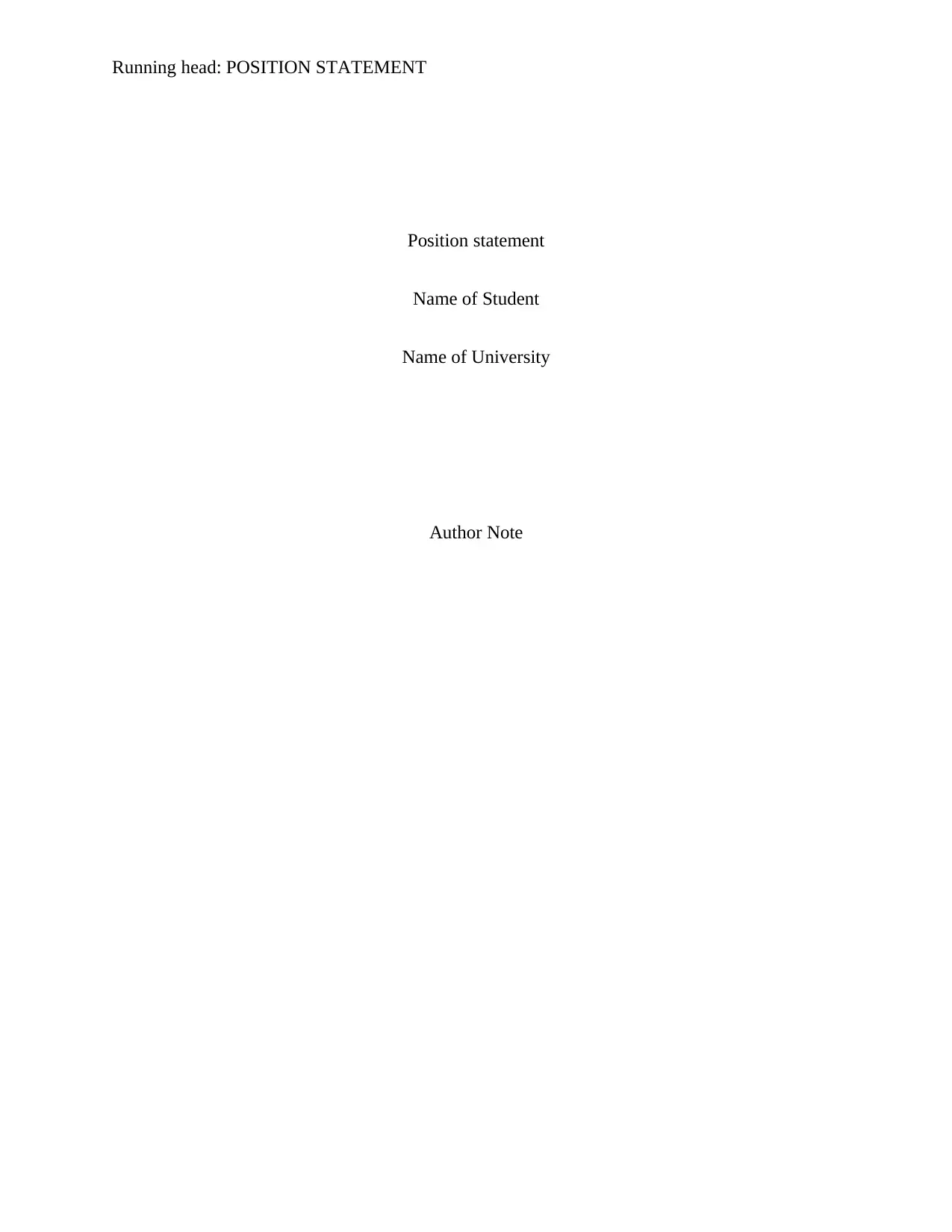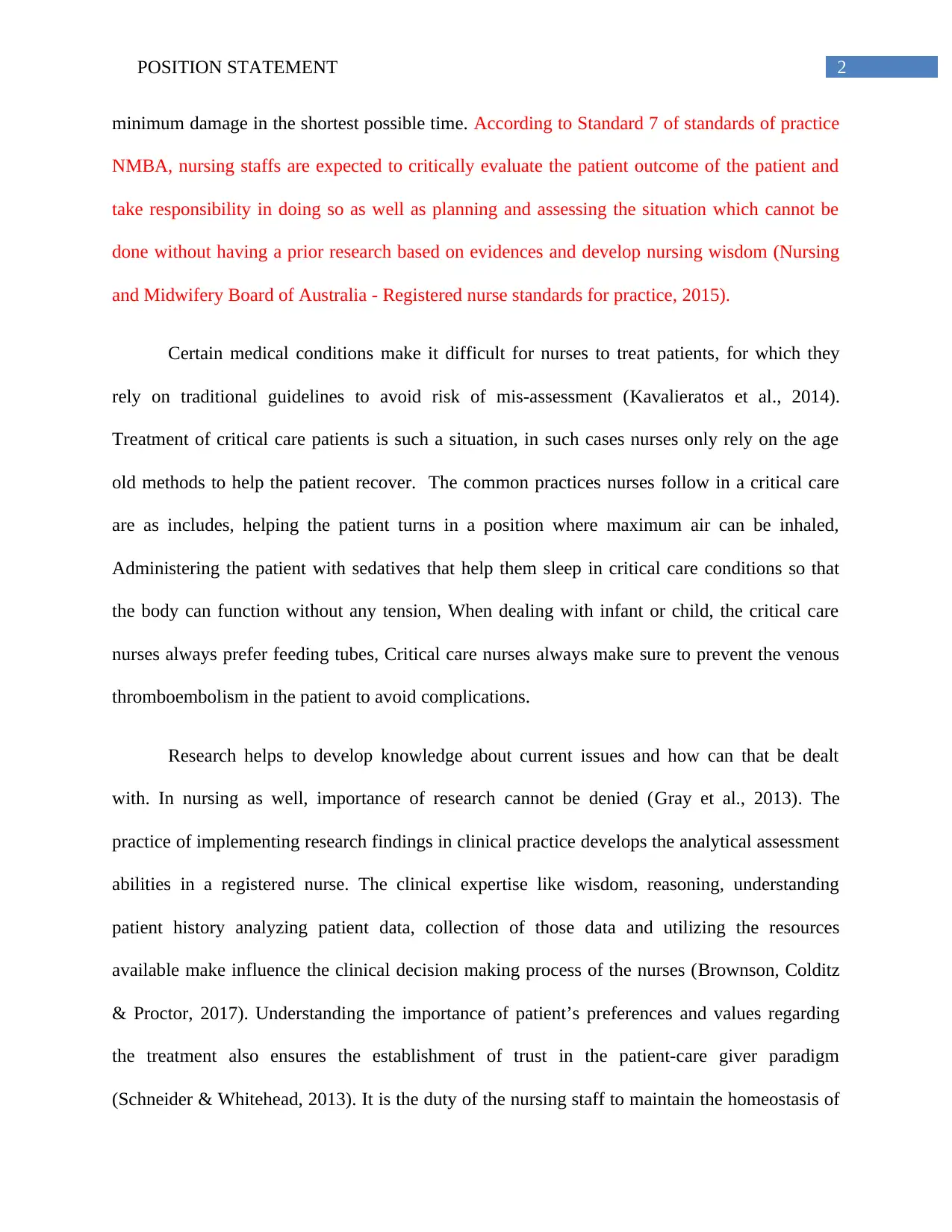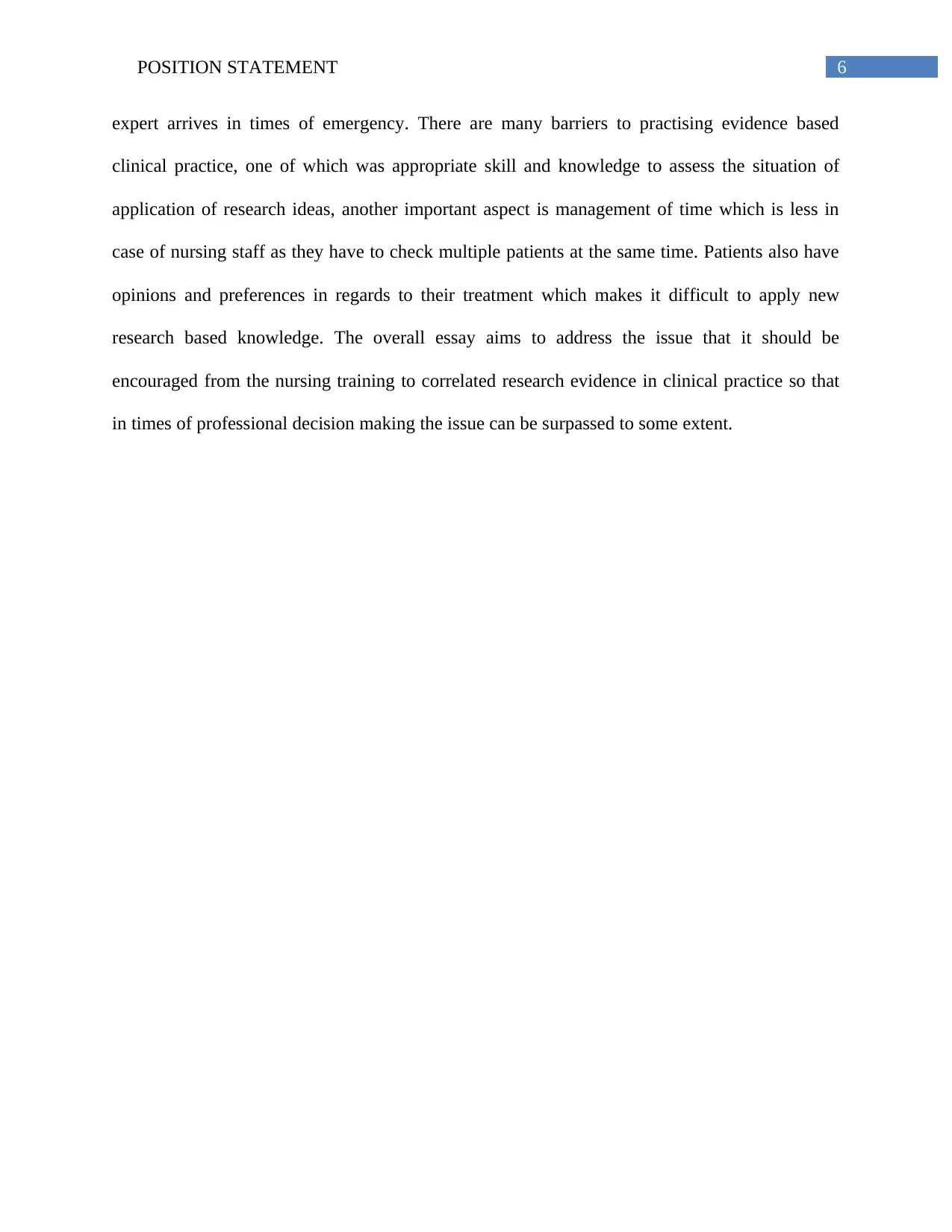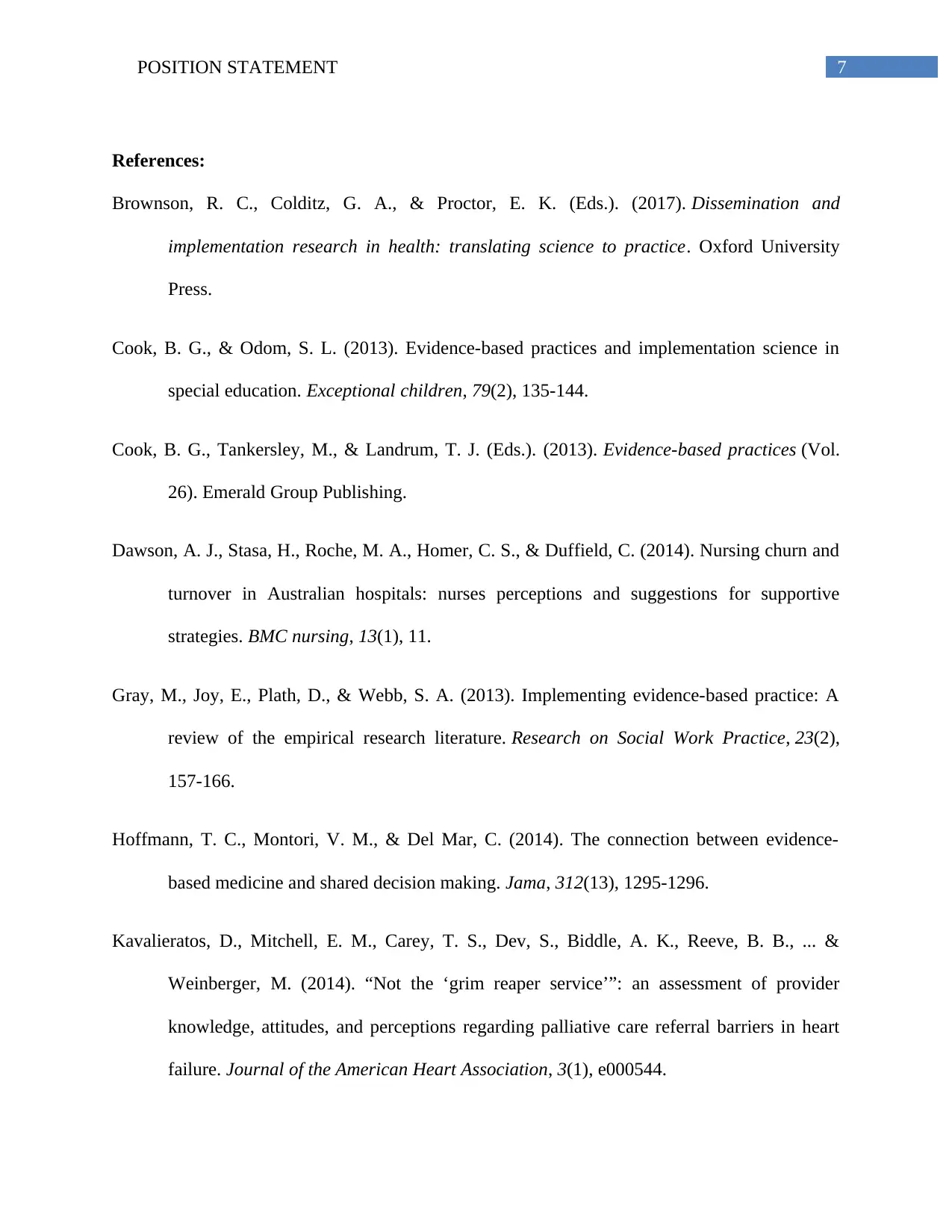Evidence-Based Practice in Nursing: A Comprehensive Position Statement
VerifiedAdded on 2021/04/16
|10
|2364
|153
Essay
AI Summary
This essay presents a position statement on the implementation of evidence-based practice (EBP) in nursing, arguing that while nurses are expected to integrate research findings into their practice, it is not reasonable to expect them to be at the forefront of EBP implementation due to a lack of comprehensive training. The paper defines EBP as the use of best available evidence, research, clinical experience, and patient preferences to improve patient care. It highlights the benefits of EBP, such as improved patient outcomes and safety, while also acknowledging the barriers to EBP implementation, including time constraints, access to evidence, knowledge gaps, and patient preferences. The essay emphasizes the importance of critical analysis and the application of theoretical knowledge in nursing practice, referencing the standards set by the Nursing and Midwifery Board of Australia (NMBA) and the International Council of Nurses (ICN). The paper also outlines a framework for integrating scientific analysis into care plans, emphasizing the need for nurses to develop EBP skills through training to improve patient care and clinical decision-making.

Running head: POSITION STATEMENT
Position statement
Name of Student
Name of University
Author Note
Position statement
Name of Student
Name of University
Author Note
Paraphrase This Document
Need a fresh take? Get an instant paraphrase of this document with our AI Paraphraser

1POSITION STATEMENT
Topic: Evidence based practice (EBP) is the clinical decision making process which is based
upon the best available evidence, new research findings, clinical experience and patient
preferences. Nurses are expected to implement research findings into their practice, but
many are not trained on how to do this. Therefore, it should not be expected that nurses
are at the forefront of EBP implementation in the clinical setting.
Evidence-based research (EBP) in nursing involves collection, evaluation and
implementation of medical data that would help improve the care service and outcome of the
patient in a healthcare setting (DiCenso, Guyatt & Ciliska, 2014). Clinicians and registered
nurses rely on their own experience and expertise to analyze research findings that would benefit
patients. EBP understands the patient’s requirements, preferences and values while respecting
boundaries and provides a safe clinical service (LoBiondo-Wood & Haber, 2017). It has to be
kept in mind that registered nurses have a big responsibility when it comes to patient safety and
care, even if doctors and perform first hand assessment of the patient’s situation before nurses.
So, the Position Statement for this paper is: Registered Nurses are required to
critically analyse a situation and formulate a strategy based on best available evidence-
Standard 1 of Nursing and Midwifery Board of Australia.
There are many benefits of implementing evidence based practice in nursing like,
predicting better patient outcomes, improving the safety measures for patient as well as
improving the quality of life (Cook, Tankersley & Landrum, 2013). The recent development of
the healthcare industry has made patient demand state of the art treatment which has to be
provided with efficiency (Cook & Odom, 2013). The whole basis of incorporating research in
clinical practice is to ensure that the best possible treatment is provided to the patients with
Topic: Evidence based practice (EBP) is the clinical decision making process which is based
upon the best available evidence, new research findings, clinical experience and patient
preferences. Nurses are expected to implement research findings into their practice, but
many are not trained on how to do this. Therefore, it should not be expected that nurses
are at the forefront of EBP implementation in the clinical setting.
Evidence-based research (EBP) in nursing involves collection, evaluation and
implementation of medical data that would help improve the care service and outcome of the
patient in a healthcare setting (DiCenso, Guyatt & Ciliska, 2014). Clinicians and registered
nurses rely on their own experience and expertise to analyze research findings that would benefit
patients. EBP understands the patient’s requirements, preferences and values while respecting
boundaries and provides a safe clinical service (LoBiondo-Wood & Haber, 2017). It has to be
kept in mind that registered nurses have a big responsibility when it comes to patient safety and
care, even if doctors and perform first hand assessment of the patient’s situation before nurses.
So, the Position Statement for this paper is: Registered Nurses are required to
critically analyse a situation and formulate a strategy based on best available evidence-
Standard 1 of Nursing and Midwifery Board of Australia.
There are many benefits of implementing evidence based practice in nursing like,
predicting better patient outcomes, improving the safety measures for patient as well as
improving the quality of life (Cook, Tankersley & Landrum, 2013). The recent development of
the healthcare industry has made patient demand state of the art treatment which has to be
provided with efficiency (Cook & Odom, 2013). The whole basis of incorporating research in
clinical practice is to ensure that the best possible treatment is provided to the patients with

2POSITION STATEMENT
minimum damage in the shortest possible time. According to Standard 7 of standards of practice
NMBA, nursing staffs are expected to critically evaluate the patient outcome of the patient and
take responsibility in doing so as well as planning and assessing the situation which cannot be
done without having a prior research based on evidences and develop nursing wisdom (Nursing
and Midwifery Board of Australia - Registered nurse standards for practice, 2015).
Certain medical conditions make it difficult for nurses to treat patients, for which they
rely on traditional guidelines to avoid risk of mis-assessment (Kavalieratos et al., 2014).
Treatment of critical care patients is such a situation, in such cases nurses only rely on the age
old methods to help the patient recover. The common practices nurses follow in a critical care
are as includes, helping the patient turns in a position where maximum air can be inhaled,
Administering the patient with sedatives that help them sleep in critical care conditions so that
the body can function without any tension, When dealing with infant or child, the critical care
nurses always prefer feeding tubes, Critical care nurses always make sure to prevent the venous
thromboembolism in the patient to avoid complications.
Research helps to develop knowledge about current issues and how can that be dealt
with. In nursing as well, importance of research cannot be denied (Gray et al., 2013). The
practice of implementing research findings in clinical practice develops the analytical assessment
abilities in a registered nurse. The clinical expertise like wisdom, reasoning, understanding
patient history analyzing patient data, collection of those data and utilizing the resources
available make influence the clinical decision making process of the nurses (Brownson, Colditz
& Proctor, 2017). Understanding the importance of patient’s preferences and values regarding
the treatment also ensures the establishment of trust in the patient-care giver paradigm
(Schneider & Whitehead, 2013). It is the duty of the nursing staff to maintain the homeostasis of
minimum damage in the shortest possible time. According to Standard 7 of standards of practice
NMBA, nursing staffs are expected to critically evaluate the patient outcome of the patient and
take responsibility in doing so as well as planning and assessing the situation which cannot be
done without having a prior research based on evidences and develop nursing wisdom (Nursing
and Midwifery Board of Australia - Registered nurse standards for practice, 2015).
Certain medical conditions make it difficult for nurses to treat patients, for which they
rely on traditional guidelines to avoid risk of mis-assessment (Kavalieratos et al., 2014).
Treatment of critical care patients is such a situation, in such cases nurses only rely on the age
old methods to help the patient recover. The common practices nurses follow in a critical care
are as includes, helping the patient turns in a position where maximum air can be inhaled,
Administering the patient with sedatives that help them sleep in critical care conditions so that
the body can function without any tension, When dealing with infant or child, the critical care
nurses always prefer feeding tubes, Critical care nurses always make sure to prevent the venous
thromboembolism in the patient to avoid complications.
Research helps to develop knowledge about current issues and how can that be dealt
with. In nursing as well, importance of research cannot be denied (Gray et al., 2013). The
practice of implementing research findings in clinical practice develops the analytical assessment
abilities in a registered nurse. The clinical expertise like wisdom, reasoning, understanding
patient history analyzing patient data, collection of those data and utilizing the resources
available make influence the clinical decision making process of the nurses (Brownson, Colditz
& Proctor, 2017). Understanding the importance of patient’s preferences and values regarding
the treatment also ensures the establishment of trust in the patient-care giver paradigm
(Schneider & Whitehead, 2013). It is the duty of the nursing staff to maintain the homeostasis of
⊘ This is a preview!⊘
Do you want full access?
Subscribe today to unlock all pages.

Trusted by 1+ million students worldwide

3POSITION STATEMENT
the patient-caregiver relationship transparent so as to ensure better care service (Dawson et al.,
2014). All this affect the well being of the patient and ensures the positive outcome of the patient
care.
It is generally preferred to perform EBP as it is known to reduce risk of rehospitalisation,
progression of a chronic diseases, cost of treatment, reduce post operative complication,
infection and spreading of diseases from an infected patient. Prevention of wrong medication
administration and gap in patient handover is not possible without evidence based practice
(Hoffmann, Montori & Del Mar, 2014). According to Standard 6 of the NMBA’s RN standards,
an RN “Provides safe, appropriate and responsive quality nursing practice”, by meeting the goal
of patient care and adhering to their own scope of practice to provide patient with safe and
quality of service and minimize risk of assessment (Nursing and Midwifery Board of Australia -
Registered nurse standards for practice, 2015).
Theoretical knowledge helps develop am framework for nursing strategies that could be
gathered from traditional knowledge, authoritative advice and current scientific data. The
concepts and theoretical understanding create the basic knowledge needed for clinical
assessment in care givers (Thomas & Law, 2013). The development of reasoning skills of
deduction, innovation of ideas and inductive reasoning develops from general assumptions is
facilitated by theoretical knowledge (LoBiondo-Wood & Haber, 2017). This helps to apply a
direction for a common goal, leading to develop strategy for improved patient care and rationale
to take clinical decisions.
It is important to develop the EBP to promote change in the healthcare institution. The
integration of EBP in the clinical practice can be done by formulating a framework of care plan.
the patient-caregiver relationship transparent so as to ensure better care service (Dawson et al.,
2014). All this affect the well being of the patient and ensures the positive outcome of the patient
care.
It is generally preferred to perform EBP as it is known to reduce risk of rehospitalisation,
progression of a chronic diseases, cost of treatment, reduce post operative complication,
infection and spreading of diseases from an infected patient. Prevention of wrong medication
administration and gap in patient handover is not possible without evidence based practice
(Hoffmann, Montori & Del Mar, 2014). According to Standard 6 of the NMBA’s RN standards,
an RN “Provides safe, appropriate and responsive quality nursing practice”, by meeting the goal
of patient care and adhering to their own scope of practice to provide patient with safe and
quality of service and minimize risk of assessment (Nursing and Midwifery Board of Australia -
Registered nurse standards for practice, 2015).
Theoretical knowledge helps develop am framework for nursing strategies that could be
gathered from traditional knowledge, authoritative advice and current scientific data. The
concepts and theoretical understanding create the basic knowledge needed for clinical
assessment in care givers (Thomas & Law, 2013). The development of reasoning skills of
deduction, innovation of ideas and inductive reasoning develops from general assumptions is
facilitated by theoretical knowledge (LoBiondo-Wood & Haber, 2017). This helps to apply a
direction for a common goal, leading to develop strategy for improved patient care and rationale
to take clinical decisions.
It is important to develop the EBP to promote change in the healthcare institution. The
integration of EBP in the clinical practice can be done by formulating a framework of care plan.
Paraphrase This Document
Need a fresh take? Get an instant paraphrase of this document with our AI Paraphraser

4POSITION STATEMENT
Incorporating scientific analysis into the care plan has become a necessity in today’s day and
age. The following step is to develop a set of questionnaire that will help both the nurse and
patient cooperate and devise a clinical action. The main parameters of this questionnaire are as
follows- P: type of patient and population which includes a patient’s ethnicity, race and problem,
I: interventional procedure and treatment method, C: considering alternative methods of
treatment in case the patient does not respond properly to the current regimen, O- deciding for
the outcome of the treatment and T: stands for deciding the timing of the treatment (Melnyk et
al., 2014). The similar practice is set by the standards of NMBA, Standard 5 when an RN
“Develops a plan for nursing practice”, this plan of action requires understanding of the patient
situation, formulate a contingency based of the available evidence that comes from prior research
will only help in the betterment of patient outcome (Nursing and Midwifery Board of Australia -
Registered nurse standards for practice, 2015).
According to the standards of registered nurses set by the Nursing and midwifery board
of Australia (NMBA), The standard statement 1, it is expected of a registered nurse to use a
variety of clinical strategies from the best option available while making clinical decisions to
provide safe, and quality care by using patient centric, assessments using frameworks of
evidence based practice guidelines (Nursing and Midwifery Board of Australia - Registered
nurse standards for practice, 2015).
The International Council of Nurses (ICN) Australia, Clause 3 of also has a set of Code
of Ethics for nursing staff, which states that evidence based practice is the root cause that defines
the activity of a registered nurse and links clinical practice with patient care (The ICN code of
ethics for nurses, 2012).
Incorporating scientific analysis into the care plan has become a necessity in today’s day and
age. The following step is to develop a set of questionnaire that will help both the nurse and
patient cooperate and devise a clinical action. The main parameters of this questionnaire are as
follows- P: type of patient and population which includes a patient’s ethnicity, race and problem,
I: interventional procedure and treatment method, C: considering alternative methods of
treatment in case the patient does not respond properly to the current regimen, O- deciding for
the outcome of the treatment and T: stands for deciding the timing of the treatment (Melnyk et
al., 2014). The similar practice is set by the standards of NMBA, Standard 5 when an RN
“Develops a plan for nursing practice”, this plan of action requires understanding of the patient
situation, formulate a contingency based of the available evidence that comes from prior research
will only help in the betterment of patient outcome (Nursing and Midwifery Board of Australia -
Registered nurse standards for practice, 2015).
According to the standards of registered nurses set by the Nursing and midwifery board
of Australia (NMBA), The standard statement 1, it is expected of a registered nurse to use a
variety of clinical strategies from the best option available while making clinical decisions to
provide safe, and quality care by using patient centric, assessments using frameworks of
evidence based practice guidelines (Nursing and Midwifery Board of Australia - Registered
nurse standards for practice, 2015).
The International Council of Nurses (ICN) Australia, Clause 3 of also has a set of Code
of Ethics for nursing staff, which states that evidence based practice is the root cause that defines
the activity of a registered nurse and links clinical practice with patient care (The ICN code of
ethics for nurses, 2012).

5POSITION STATEMENT
There are many barriers when it comes to evidence based practice in nursing which are
time management, access to evidence, knowledge and skill and patient preference.
Time management: This is the most important aspect of evidence based practice. The
growing rate of hospitalizations and illness all over the world has made it difficult for nurses to
find time for research. The registered nurses has to check many patients dealing with different
problem under one single ward which makes it difficult for them to appraises research data in the
duty routine.
Access to evidence: it is not possible for registered nurses to have access to peer
reviewed journals and understand the level of all clinical research papers
Knowledge and skill: the registered nurses do not have as much knowledge as a
practitioner which would enable them to understand the scientific implications of clinical
research, which makes it difficult to practise evidence inclusive clinical assessment (Gray et al.,
2013).
Patient preferences: it is important for a nurse to value the preference of patients when it
comes to good clinical practice. Sometimes, that becomes a barrier to make clinical judgement,
for which it is required to gain trust of the patient and make them understand the importance of
the agreed upon intervention (Hoffmann, Montori & Del Mar, 2014).
The discussion above makes it clear that evidence based practice improves the outcome
of patients and that evidence could be based on traditional knowledge or current scientific
research. Nurses hold a responsible position in the healthcare industry which makes it difficult
for them to assess the patient situation as good as the practitioner, similarly it is expected that
registered nurses have the minimum skills and knowledge to perform procedures before the
There are many barriers when it comes to evidence based practice in nursing which are
time management, access to evidence, knowledge and skill and patient preference.
Time management: This is the most important aspect of evidence based practice. The
growing rate of hospitalizations and illness all over the world has made it difficult for nurses to
find time for research. The registered nurses has to check many patients dealing with different
problem under one single ward which makes it difficult for them to appraises research data in the
duty routine.
Access to evidence: it is not possible for registered nurses to have access to peer
reviewed journals and understand the level of all clinical research papers
Knowledge and skill: the registered nurses do not have as much knowledge as a
practitioner which would enable them to understand the scientific implications of clinical
research, which makes it difficult to practise evidence inclusive clinical assessment (Gray et al.,
2013).
Patient preferences: it is important for a nurse to value the preference of patients when it
comes to good clinical practice. Sometimes, that becomes a barrier to make clinical judgement,
for which it is required to gain trust of the patient and make them understand the importance of
the agreed upon intervention (Hoffmann, Montori & Del Mar, 2014).
The discussion above makes it clear that evidence based practice improves the outcome
of patients and that evidence could be based on traditional knowledge or current scientific
research. Nurses hold a responsible position in the healthcare industry which makes it difficult
for them to assess the patient situation as good as the practitioner, similarly it is expected that
registered nurses have the minimum skills and knowledge to perform procedures before the
⊘ This is a preview!⊘
Do you want full access?
Subscribe today to unlock all pages.

Trusted by 1+ million students worldwide

6POSITION STATEMENT
expert arrives in times of emergency. There are many barriers to practising evidence based
clinical practice, one of which was appropriate skill and knowledge to assess the situation of
application of research ideas, another important aspect is management of time which is less in
case of nursing staff as they have to check multiple patients at the same time. Patients also have
opinions and preferences in regards to their treatment which makes it difficult to apply new
research based knowledge. The overall essay aims to address the issue that it should be
encouraged from the nursing training to correlated research evidence in clinical practice so that
in times of professional decision making the issue can be surpassed to some extent.
expert arrives in times of emergency. There are many barriers to practising evidence based
clinical practice, one of which was appropriate skill and knowledge to assess the situation of
application of research ideas, another important aspect is management of time which is less in
case of nursing staff as they have to check multiple patients at the same time. Patients also have
opinions and preferences in regards to their treatment which makes it difficult to apply new
research based knowledge. The overall essay aims to address the issue that it should be
encouraged from the nursing training to correlated research evidence in clinical practice so that
in times of professional decision making the issue can be surpassed to some extent.
Paraphrase This Document
Need a fresh take? Get an instant paraphrase of this document with our AI Paraphraser

7POSITION STATEMENT
References:
Brownson, R. C., Colditz, G. A., & Proctor, E. K. (Eds.). (2017). Dissemination and
implementation research in health: translating science to practice. Oxford University
Press.
Cook, B. G., & Odom, S. L. (2013). Evidence-based practices and implementation science in
special education. Exceptional children, 79(2), 135-144.
Cook, B. G., Tankersley, M., & Landrum, T. J. (Eds.). (2013). Evidence-based practices (Vol.
26). Emerald Group Publishing.
Dawson, A. J., Stasa, H., Roche, M. A., Homer, C. S., & Duffield, C. (2014). Nursing churn and
turnover in Australian hospitals: nurses perceptions and suggestions for supportive
strategies. BMC nursing, 13(1), 11.
Gray, M., Joy, E., Plath, D., & Webb, S. A. (2013). Implementing evidence-based practice: A
review of the empirical research literature. Research on Social Work Practice, 23(2),
157-166.
Hoffmann, T. C., Montori, V. M., & Del Mar, C. (2014). The connection between evidence-
based medicine and shared decision making. Jama, 312(13), 1295-1296.
Kavalieratos, D., Mitchell, E. M., Carey, T. S., Dev, S., Biddle, A. K., Reeve, B. B., ... &
Weinberger, M. (2014). “Not the ‘grim reaper service’”: an assessment of provider
knowledge, attitudes, and perceptions regarding palliative care referral barriers in heart
failure. Journal of the American Heart Association, 3(1), e000544.
References:
Brownson, R. C., Colditz, G. A., & Proctor, E. K. (Eds.). (2017). Dissemination and
implementation research in health: translating science to practice. Oxford University
Press.
Cook, B. G., & Odom, S. L. (2013). Evidence-based practices and implementation science in
special education. Exceptional children, 79(2), 135-144.
Cook, B. G., Tankersley, M., & Landrum, T. J. (Eds.). (2013). Evidence-based practices (Vol.
26). Emerald Group Publishing.
Dawson, A. J., Stasa, H., Roche, M. A., Homer, C. S., & Duffield, C. (2014). Nursing churn and
turnover in Australian hospitals: nurses perceptions and suggestions for supportive
strategies. BMC nursing, 13(1), 11.
Gray, M., Joy, E., Plath, D., & Webb, S. A. (2013). Implementing evidence-based practice: A
review of the empirical research literature. Research on Social Work Practice, 23(2),
157-166.
Hoffmann, T. C., Montori, V. M., & Del Mar, C. (2014). The connection between evidence-
based medicine and shared decision making. Jama, 312(13), 1295-1296.
Kavalieratos, D., Mitchell, E. M., Carey, T. S., Dev, S., Biddle, A. K., Reeve, B. B., ... &
Weinberger, M. (2014). “Not the ‘grim reaper service’”: an assessment of provider
knowledge, attitudes, and perceptions regarding palliative care referral barriers in heart
failure. Journal of the American Heart Association, 3(1), e000544.

8POSITION STATEMENT
LoBiondo-Wood, G., & Haber, J. (2017). Nursing Research-E-Book: Methods and Critical
Appraisal for Evidence-Based Practice. Elsevier Health Sciences.
Melnyk, B. M., Gallagher‐Ford, L., Long, L. E., & Fineout‐Overholt, E. (2014). The
establishment of evidence‐based practice competencies for practicing registered nurses
and advanced practice nurses in real‐world clinical settings: proficiencies to improve
healthcare quality, reliability, patient outcomes, and costs. Worldviews on Evidence
‐
Based Nursing, 11(1), 5-15.
Nursing and Midwifery Board of Australia - Registered nurse standards for practice.
(2015). Nursingmidwiferyboard.gov.au. Retrieved 27 March 2018, from
http://www.nursingmidwiferyboard.gov.au/Codes-Guidelines-Statements/Professional-
standards/registered-nurse-standards-for-practice.aspx
Schneider, Z., & Whitehead, D. (2013). Nursing and midwifery research: methods and appraisal
for evidence-based practice. Elsevier Australia.
The ICN code of ethics for nurses. (2012) (p. 3). Geneva.
Thomas, A., & Law, M. (2013). Research utilization and evidence-based practice in occupational
therapy: A scoping study. American Journal of Occupational Therapy, 67(4), e55-e65.
LoBiondo-Wood, G., & Haber, J. (2017). Nursing Research-E-Book: Methods and Critical
Appraisal for Evidence-Based Practice. Elsevier Health Sciences.
Melnyk, B. M., Gallagher‐Ford, L., Long, L. E., & Fineout‐Overholt, E. (2014). The
establishment of evidence‐based practice competencies for practicing registered nurses
and advanced practice nurses in real‐world clinical settings: proficiencies to improve
healthcare quality, reliability, patient outcomes, and costs. Worldviews on Evidence
‐
Based Nursing, 11(1), 5-15.
Nursing and Midwifery Board of Australia - Registered nurse standards for practice.
(2015). Nursingmidwiferyboard.gov.au. Retrieved 27 March 2018, from
http://www.nursingmidwiferyboard.gov.au/Codes-Guidelines-Statements/Professional-
standards/registered-nurse-standards-for-practice.aspx
Schneider, Z., & Whitehead, D. (2013). Nursing and midwifery research: methods and appraisal
for evidence-based practice. Elsevier Australia.
The ICN code of ethics for nurses. (2012) (p. 3). Geneva.
Thomas, A., & Law, M. (2013). Research utilization and evidence-based practice in occupational
therapy: A scoping study. American Journal of Occupational Therapy, 67(4), e55-e65.
⊘ This is a preview!⊘
Do you want full access?
Subscribe today to unlock all pages.

Trusted by 1+ million students worldwide

9POSITION STATEMENT
1 out of 10
Related Documents
Your All-in-One AI-Powered Toolkit for Academic Success.
+13062052269
info@desklib.com
Available 24*7 on WhatsApp / Email
![[object Object]](/_next/static/media/star-bottom.7253800d.svg)
Unlock your academic potential
Copyright © 2020–2025 A2Z Services. All Rights Reserved. Developed and managed by ZUCOL.




